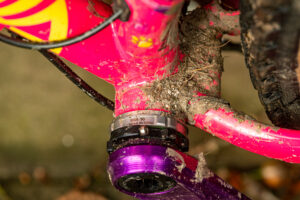Merida Ninety-Six XC full-suspension range gets a fresh look and a down-country makeover. Available in two versions: 100mm RC and a 120mm down-country bike.
Merida Ninety-Six 8000 review
The Merida Ninety-Six has been a stalwart of the XC and marathon race scene for many years now. It was the whip of choice for XC legends Gunn-Rita Dahle Flesjå and José Hermida on the gnarlier tracks of the World Cup circuit, as well as hugely popular among privateer racers in countries like Hermida’s native Spain. For 2020 it had a timely revamp, as the old model was getting long in the tooth and hamstrung by outdated geometry, a clumsy remote lockout and an antique front derailleur mount (remember them).
Read more: Best XC race bikes – hardtail and full suspension
With elite riders like Gunn-Rita Dahle Flesjå and José Hermida, Merida is an undisputed XC powerhouse – Dahle Flesja winning over 30 XC World Cups, Hermida racking up three World Championship gold medals. Their bike of choice for 2021 and beyond? The new Merida Ninety-Six.

Merida Ninety-Six 8000 review
Available in RC and regular options, all Ninety-Six models are built around the same full carbon chassis, where fork travel changes to tweak the geometry and ride characteristics. Basically, the RC bikes get 100mm suspension forks, while the more trail-focused ride – the Ninety-Six 8000 tested here is the only model – gets 120mm up front.
And while 20mm extra fork travel doesn’t sound like a big difference, it’s enough to have a positive impact on the geometry: namely, slackening the head angle by more than one degree to 67.1°, while raising the height of the front end, which we’ll get to in just a minute.
The full carbon frame has all the features you’d expect from a modern short-travel rig, including a weight saving flex-stay suspension design which, unlike most Meridas we’ve tested, nearly delivers all of its claimed 100mm of travel. Cable routing is internal, where the entry ports are through the headset rather than the head tube, eliminating the need for holes in this high-stress area. A steering lock headset would be a great addition here to protect the frame, though, as even with the stem flipped to raise the bar, the controls don’t clear the top tube when turned 90°.

96mm-travel SIDLuxe shock prioritise speed over sensitivity and features lockout
Suspension
With the 44mm-stroke RockShox SIDLuxe shock delivering 96mm travel, this is a relatively low-leverage-ratio design. So even with the smaller SID damper, overheating won’t be an issue here. The low-leverage design combined with the linkage layout means the suspension is not as sensitive as the Specialized, though – it’s XC DNA selecting for improved pedalling efficiency over bump absorption. Another XC throwback is the RockShox TwistLoc handlebar remote that enables you to lock out the shock and SID Ultimate fork in an instant. The rebound adjuster on the shock is hidden below the lockout, so the shock ships with the dials facing away from the frame so you can access the rebound with a hex key. Once you have the rebound dialled in, flipping the shock will give a cleaner, more direct cable route for the remote lockout.

Two-piston rear brake feels vague compared to the four-piston front
Components
Merida fits a 60mm stem with -20° rise to the Ninety-Six 8000, and thank goodness it does. Only by inverting the stem were we able to raise the handlebar height and achieve a more comfortable and commanding riding position with the relatively narrow 740mm bar; Merida’s lock-on grip collars reducing the effective bar width further.
XC riders push bigger gears, so it’s fitting that the Merida gets a 34t chainring. Thankfully, it complements it with the wider-range 10-52t SRAM Eagle cassette, so regular riders can keep the 175mm cranks spinning for longer. Merida mixes a Shimano XT four-piston front brake with a two-piston rear, the idea being to boost stopping power, but unfortunately the brakes feel slightly different, with the two-piston rear brake having a more sluggish lever action.

Cockpit is too low and narrow even with -20° stem flipped
Performance
While we welcomed the slacker head angle that the 120mm-travel SID fork affords, the associated increase in BB height and reduction in reach negatively impact handling on the Ninety-Six 8000. As a result, the Merida feels short, upright and tall. Combined with the XC-focused rear suspension, the Merida lacks the traction and control to be a true trailblazer. Running the shock with more sag lowered the BB and offered a more compliant ride, but even with 35 per cent sag we never achieved full travel.
Yes, the top-quality Maxxis tyres provide improved braking and climbing traction but they also rob the Merida of rolling speed, which defeats the point of having a lightweight bike to begin with.

Verdict
We’d love to say that through select component choices like the 120mm-travel RockShox SID fork and Maxxis tyres, the new Merida Ninety-Six 8000 blurs the line between XC racing and trail riding. Sadly, it doesn’t. The suspension and geometry have both feet firmly planted in XC racing and, if anything, the taller fork negatively impacts the bike in other ways. So while the RC version of Ninety-Six is probably a capable XC race bike, the changes to the build kit that Merida has made to make the 8000 more versatile, are actually counter-productive.
















